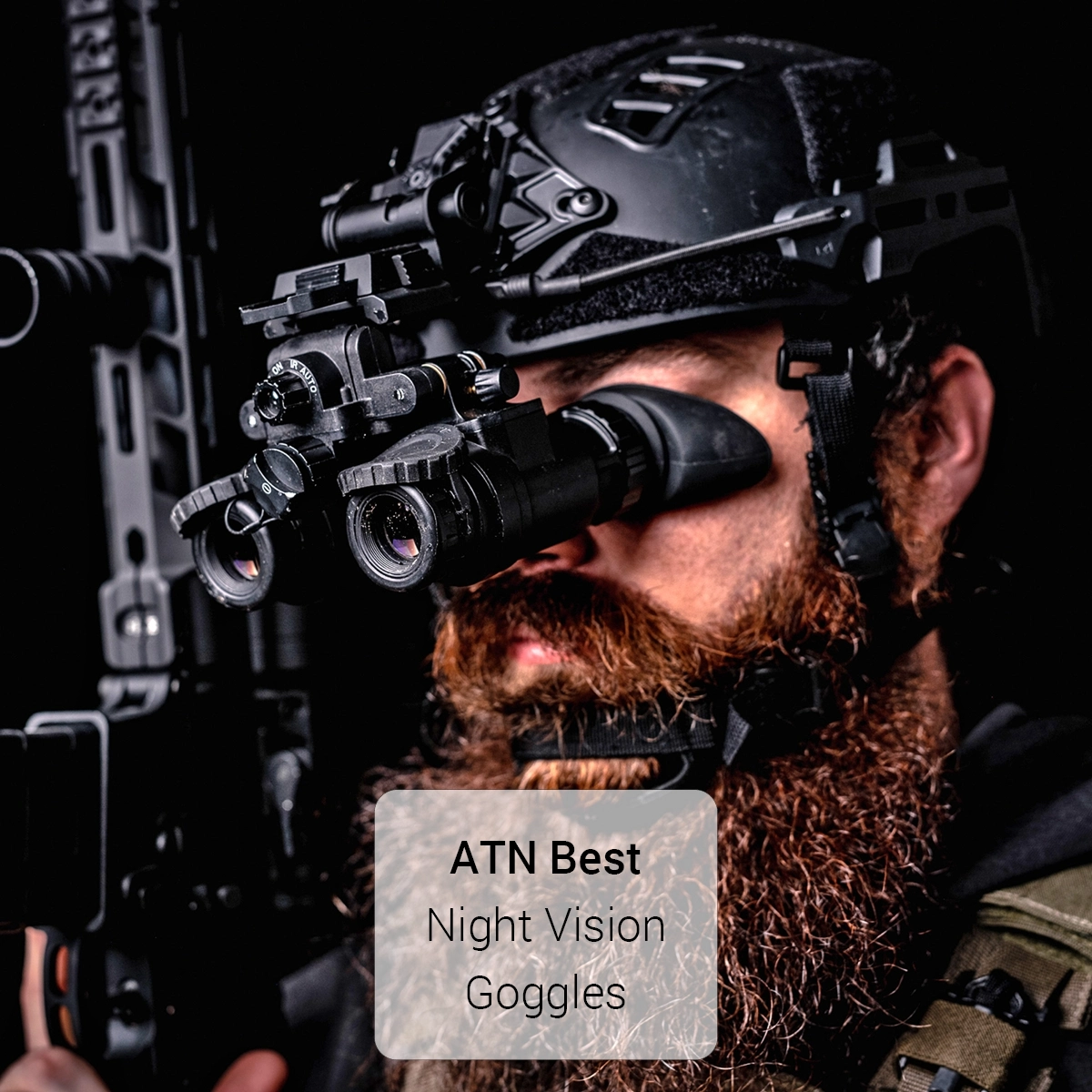OUR Best Night Vision Goggles in 2023
Night vision technology, originally developed for military purposes, is now widely utilized in a range of fields such as nocturnal wildlife observation and security surveillance. The current market for night vision equipment offers a diverse selection, among which goggles have garnered attention for their blend of technological innovation and ease of use. To choose the most fitting product, understanding the basics of night vision technology and identifying the key features that differentiate superior goggles is essential.

In this review, we examine two significant models in the current market: the PS31 series and the PVS7 series. Our objective is to provide an in-depth analysis of each, exploring their individual features, advantages, and potential drawbacks. This information will serve as a valuable guide for potential buyers, helping you select the best night vision goggles tailored to your specific needs.
The Basics of Night Vision Technology
Night vision technology has revolutionized the way we perceive and interact with our surroundings in low light or complete darkness. However, to appreciate and effectively utilize the best night vision goggles, it's vital to understand the fundamental technology that powers them. The core technologies in this field encompass Image Intensification (I2), Thermal Imaging, and Infrared Illumination. Each has unique capabilities that lend themselves to different use-cases and operational environments.
Image Intensification (I2)
Image Intensification, often associated with the term 'night vision,' is the most common technology found in night vision goggles. The process begins when photons from available light (moonlight, starlight, etc.) enter the device and strike a surface called a photocathode. The energy of the light is transformed into electrons, which are then multiplied by a microchannel plate and hit a phosphor screen, converting back into light. This amplified light is what you see when looking through the goggles - a bright green image. I2 excels in environments with some ambient light but can be less effective in complete darkness or overly bright conditions. The best night vision goggles typically utilize advanced generations of I2, offering sharper and brighter images.
Thermal Imaging
Thermal imaging, as the name suggests, is based on the heat, or infrared radiation, emitted by objects. Every object, living or non-living, emits some form of infrared radiation. Thermal imaging devices capture this radiation and translate it into an image. Unlike I2, thermal imaging works equally well in complete darkness, light, or even smoky or foggy conditions. The distinct advantage of thermal imaging is its ability to detect objects hidden by foliage or camouflage, making it an essential tool in security and wildlife observation.
Infrared Illumination
Infrared Illumination, often used in tandem with I2, is a technology designed to function in absolute darkness where I2 might falter. It works by emitting infrared light, invisible to the naked eye, but detectable by the night vision device. The goggles pick up the reflected IR light, allowing users to see in conditions with no ambient light. However, it's worth noting that while useful, infrared illumination can potentially reveal the user's position to others equipped with night vision technology.
To conclude, understanding these technologies aids in discerning the key differences between various night vision goggles, enabling informed decisions based on individual needs. The best night vision goggles seamlessly integrate these technologies, providing users with the ability to navigate and observe in an array of lighting conditions.
Key Factors to Consider when Choosing Night Vision Goggles
When choosing the best night vision goggles, several key factors need to be taken into consideration. Not all devices are created equal, and your choice should primarily be guided by your intended use, be it military, tactical, or recreational. Let's delve into the major aspects: monocular or binocular vision, generation of technology, battery life, and the purpose of the goggles.
Monocular vs. Binocular Vision
The choice between monocular and binocular goggles depends largely on your specific requirements. Monocular goggles, as the name suggests, provide a single eyepiece for viewing, which can be advantageous for tasks that require simultaneous use of natural and amplified vision. They are often lighter and more compact, making them a good choice for lightweight travel and quick observations.
Binocular models, on the other hand, offer two eyepieces, which can provide a more comfortable viewing experience for extended use and deliver better depth perception. This is particularly helpful in activities like navigation or identification of objects in the dark. However, they are generally heavier and may be more expensive.
Generation of Technology
Night vision devices are categorized into different generations (Gen 0 to Gen 4), with each generation offering improvements over the previous one. Gen 1 devices are the most affordable but offer lower image quality and shorter range. As we move up the generations, the devices offer better image quality, range, and battery life, but also increase in cost. Gen 3 and above are commonly used by the military and other professionals due to their superior performance.
Battery Life
The battery life of your goggles is a critical factor to consider, particularly if you plan to use them for extended periods. It's important to note that battery life can be affected by factors like the generation of the device, the use of infrared illuminators, and the type of batteries used. Look for models that offer long battery life, or those that allow for easy battery changes in the field.
Purpose of the Goggles
Your intended use for the goggles can significantly influence your choice. If you're looking for goggles for professional military or tactical use, you'll likely need high-end, durable models with advanced generation technology. These typically offer superior image quality, longer range, and additional features like infrared illuminators. For recreational purposes such as wildlife observation or stargazing, a less expensive model with a balance of image quality and ease of use may suffice.
Step-by-Step Guide to Choosing Night Vision Goggles:
- Define Your Purpose. Understand what you'll primarily use the goggles for. Different activities necessitate different features.
- Choose Between Monocular and Binocular. Monocular devices are lightweight and portable, while binocular ones offer better depth perception.
- Decide on the Generation. Higher generations offer better performance but come at a higher cost. Choose according to your budget and needs.
- Check Battery Life. Ensure the device offers sufficient battery life for your planned usage. Consider models that use commonly available batteries for easy replacement.
- Compare and Contrast. Finally, compare various models within your criteria, considering factors like brand reputation, warranty, and customer reviews.
By considering these factors, you will be well-equipped to make an informed choice and find the night vision goggles best suited to your needs.
Product Review: PS31 Series
The PS31 series of night vision goggles holds a prominent position in the market, celebrated for its advanced features and reliable performance. Often considered among the best night vision for the money, this series offers a compelling balance of technical sophistication, ease of use, and value. Built with Gen 3 technology, the PS31 series provides clear and sharp vision in low light conditions. Its image intensification is powerful, enabling users to detect and identify objects at considerable distances. As a result, these goggles are a popular choice in both military and tactical operations, where precision and clarity are paramount.
One key feature of the PS31 series is its binocular design. With two eyepieces, users can comfortably observe their surroundings for extended periods without experiencing the discomfort or fatigue often associated with monocular devices. This design also significantly improves depth perception, making navigation in the dark safer and more efficient.
The PS31 series also excels in terms of battery life. Its energy-efficient design ensures prolonged operation, minimizing the need for frequent battery replacements during critical missions or extended outdoor activities. Additionally, these goggles are compatible with commonly available batteries, making it easy to find replacements when necessary.
Magnification is another area where the PS31 series shines. Unlike many other night vision goggles, which may only offer 1x magnification, this series provides several magnification options, further enhancing its versatility.
Pros:
- High-quality Gen 3 technology provides excellent vision in low light conditions.
- Binocular design enhances viewing comfort and improves depth perception.
- Long battery life with compatibility to commonly available batteries.
- Offers several magnification options for increased versatility.
- Durable and robust construction suitable for military and tactical use.
Cons:
- Higher cost compared to some other models, due to the advanced features.
- While the binocular design enhances viewing, it does add to the weight of the goggles.
- The device might be too advanced for recreational users who simply need basic night vision capabilities.
In summary, the PS31 series offers a robust set of features that justify its position among the best tactical night vision goggles. With its powerful Gen 3 technology, comfortable binocular design, long battery life, and variable magnification options, it presents a worthwhile investment for professionals seeking reliable night vision equipment. However, recreational users or those with basic night vision needs may find this series too advanced or expensive for their requirements. As always, choosing the right night vision goggles comes down to understanding one's specific needs and budget.
Product Review: PVS7 Series
The PVS7 series is another high-quality offering in the realm of night vision goggles, boasting a range of features that make it a compelling choice for a variety of users. Some even consider it as one of the best hands free night vision goggles, thanks to its user-friendly design and impressive functionality. Much like the PS31 series, the PVS7 utilizes Gen 3 technology, delivering superb image quality in low light conditions. The image intensification process is efficient, turning minimal light into clear, visible imagery with enhanced detail. This makes the PVS7 a favorite among military and tactical users who require precise and accurate vision in the dark.
Perhaps the most significant selling point of the PVS7 series is its hands-free operational design. The goggles come with a head mount, allowing users to use their hands freely while still maintaining excellent night vision. This feature can be a game-changer in many scenarios, from navigating difficult terrain to handling equipment or weapons. The battery life of the PVS7 series is commendable, with a single charge providing hours of operation. The device also features a low battery indicator, ensuring users are never caught off guard with a sudden power outage.
In terms of magnification, the PVS7 series provides a good balance between field of view and magnification power. It offers sufficient magnification for detailed observation while maintaining a broad enough view for effective navigation and awareness of surroundings.
Pros:
- Gen 3 technology delivers excellent low-light image quality.
- Hands-free operation enhances versatility and ease of use.
- Durable battery with a low battery indicator to prevent sudden power loss.
- Adequate magnification balance, offering both detail and wide field of view.
- Rugged design suitable for harsh conditions.
Cons:
- Though the hands-free operation is a major plus, it requires additional gear (head mount), which may be cumbersome for some users.
- The price point is relatively high, potentially limiting its accessibility for some users.
- The weight of the unit, especially with the head mount, may cause discomfort over extended periods of use.
In conclusion, the PVS7 series certainly makes a case for being among the best night vision goggles. Its Gen 3 technology, hands-free operation, and balanced magnification make it a reliable tool for professional or intensive recreational use.
However, the higher price point and potential discomfort from prolonged use with the head mount are factors to consider. Therefore, as with any significant investment, potential buyers should weigh the benefits against the drawbacks and consider their specific needs before making a decision.
Comparison between PS31 and PVS7 series
When comparing the PS31 and PVS7 series of night vision goggles, it's clear that both series have been designed with quality and performance in mind. While they share some common features, they also exhibit specific characteristics that distinguish one from the other. Let's explore these in more detail.
Night Vision Technology (Gen)
Both the PS31 and PVS7 series utilize advanced Gen 3 night vision technology. This latest generation of technology enhances the user's ability to see clearly in extremely low light conditions or complete darkness. The Gen 3 technology uses a photocathode to convert photons into electrons, which are then multiplied by a microchannel plate before hitting a phosphor screen to produce a clear and detailed image. With Gen 3 technology at their core, both the PS31 and PVS7 provide users with exceptional clarity and detail.
Design and Ergonomics
Design and ergonomics play a vital role in the usability and functionality of night vision goggles. The PS31 series is designed as a traditional binocular device, with two eyepieces providing a more comfortable viewing experience and better depth perception. This can be particularly advantageous in situations where the user needs to navigate tricky terrains or identify precise details.
On the other hand, the PVS7 series, though also a binocular device, sets itself apart with its hands-free operational design. Thanks to an accompanying head mount, the PVS7 allows users to navigate and operate other equipment simultaneously, increasing its utility in dynamic environments.
Battery Life and Power Management
In terms of battery life, both series perform commendably, catering to extended usage needs. The PS31 series, with its energy-efficient design, ensures prolonged operation, reducing the frequency of battery changes during critical activities. In contrast, while the PVS7 also offers long-lasting battery life, it goes a step further by including a low battery indicator. This feature gives users a heads-up when power levels are low, preventing unexpected power outages.
Magnification and Field of View
Magnification capabilities also differ between the two series. The PS31 series provides various magnification options, allowing users to adjust according to their specific needs. This can be particularly useful in activities like wildlife observation or surveillance, where detailed views are required.
The PVS7 series, while not offering variable magnification, provides a balance that caters to most general needs. Its magnification level is sufficient for detailed observations, and it maintains a wide field of view, essential for effective navigation and maintaining situational awareness.
Comparative Table:
| Feature | PS31 Series | PVS7 Series |
|---|---|---|
| Night Vision Technology | Gen 3 | Gen 3 |
| Design | Binocular (Hands-Free) | Binocular (Hands-Free) |
| Ergonomics | Comfortable dual eyepieces | Head mount for hands-free operation |
| Battery Life | Long with energy-efficient design | Good with low battery indicator |
| Magnification | Multiple options for versatile usage | Balanced magnification and field of view |
| Field of View | Depends on magnification level | Wide for better situational awareness |
To summarize, the PS31 and PVS7 series both offer high-quality performance and feature advanced Gen 3 technology. The PS31 may be the preferred choice for users requiring variable magnification and extended battery life. The PVS7, with its hands-free operation and balanced magnification, is an excellent choice for users needing to multitask in low light conditions. Ultimately, the choice between the two will depend on the specific needs and preferences of the user.
Conclusion
In conclusion, both the PS31 and PVS7 series represent the apex of night vision technology, each delivering impressive performance in their respective ways. Both series leverage Gen 3 technology to ensure exceptional clarity and detail in low light or complete darkness, embodying the essence of night-vision capability.
The PS31 series, with its binocular design, energy-efficient battery life, and variable magnification options, offers a versatile user experience. Its traditional design provides superior depth perception and comfortable viewing over extended periods, making it an ideal choice for a variety of activities, from wildlife observation to surveillance.
The PVS7 series, on the other hand, is designed for those who value the flexibility of hands-free operation. Its head-mount design and balanced magnification offer a perfect blend of utility and performance. This, along with its robust battery life and low battery indicator, makes it a reliable companion in environments where multitasking is necessary, such as in tactical or outdoor adventure settings.
As such, the title of "best" ultimately hinges on user needs and preferences. For users seeking versatile magnification options and a traditional viewing experience, the PS31 series may prove to be the best night vision goggles. Meanwhile, those seeking the convenience of hands-free operation and balanced magnification might find the PVS7 series to be the best fit. In essence, both series of goggles stand out in their own unique ways, demonstrating why they are often regarded as some of the best in the market. By considering their specific needs and the features each series offers, users can make a well-informed decision about which night vision goggles are the best for them.






